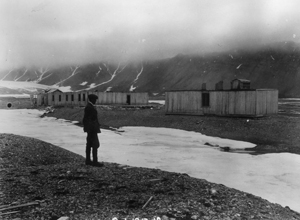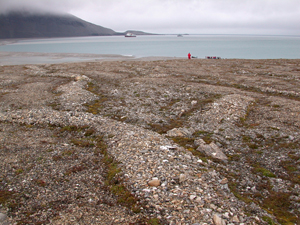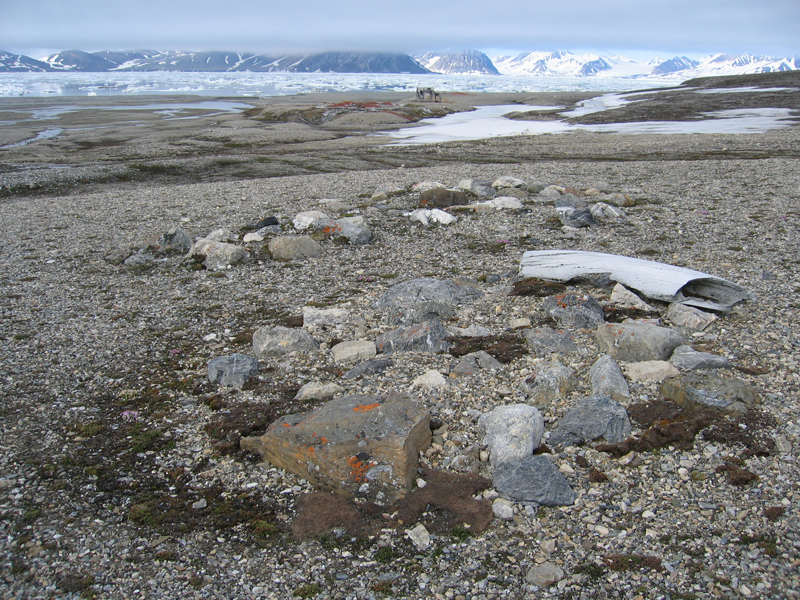Gåshamna [76° 57' N 15° 52' E]By Øystein Overrein (ed.), Jørn Henriksen, Bjørn Fossli Johansen, Kristin PrestvoldGåshamna is a relatively large and open bay on the southern shores of the Hornsund fjord, loaded with historical value. Here are remains of whaling, Russian and Norwegian overwintering trapping and remains from one of the first great international research expeditions in the Arctic. The cultural remains are vulnerable. In addition, there are exquisite examples of patterned ground, and a walk on the tundra is highly recommended. Take care:




History and cultural remainsGåshamna is situated on the southern shore of Hornsund and is marked as the best anchorage on this side of the fjord. The bay offers good protection from swells. The land comprises vegetation-free gravel and a large delta. Each year during the spring and summer melting, the delta is flooded and the meltwater creates new river courses. The cultural remains are situated on the gravelled ground, highly exposed to erosion. The oldest remains of human activity in Gåshamna can be dated back to the whaling era in the 1600-1700s. Whaling, which targeted bowhead whales, was concentrated in the summer season. The bowhead population around Svalbard collapsed during the 1700s and has never recovered. This is a tragic example of human overexploitation of natural resources. Blubber ovens, house sites and graves are the most important remains from the early European whaling, but bones at the slaughtering sites for whales and walruses can also be found. Between the larger structures you may find harpoons, clay pipes and pottery. About 50 whaling stations are registered in Svalbard – this site is one of the oldest, dating from the time when the industry was still land-based. There are remains of two large whaling stations in Gåshamna, one on each side of the river delta. Both stations were probably English and were in use between 1618 and 1650, when the English had claims to Hornsund. At the eastern station the remains consist of a house site, a large blubber oven and a burial ground with 12 graves at a small hilltop close to the station. In 1992 archaeologists excavated parts of the house site and the blubber oven, which proved to be very well preserved. The western station is located on the other side of the delta, in a vegetation-free area. This station was partly taken by the river in 1993, which led to an emergency excavation of the fragmented remains. The rest of the installation lies further in from the river and comprises house sites, graves and blubber ovens, which are all in relatively good condition. However, erosion is also a threat to this station. West in Gåshamna there are obvious embankment structures similar to those at Renardodden, Midterhuken and Lægerneset. These are tent-foundations, old house sites from the time the station was in operation. One of the sites is rectangular – 12 m long and approximately 6 m wide – with two rooms connected through a large door-opening. Around parts of the site there is a quite wide embankment made of gravel from the ground it is built on.. Around other parts there are wide stony embankments with openings along the longest wall. The vegetation is dense on the stone embankment, inside the site and in the near vicinity. Further away from the site, on the gravel terrace-like plateau, there are three blubber ovens. Two of them are situated on top of an artificial platform of gravel that probably functioned as a working platform. The evidence of human activity is gradually disappearing in the hands of nature. Between the two stations there are no remains left. . Based on the remains located on the erosion front towards the river delta, we can assume that the whole facility in Gåshamna probably covered a very large area, and that activity was high here in the first part of the 1600s. At Höferpynten, not far from the western whaling station in Gåshamna, are remains of one large and several small houses from Russian overwintering trapping. The Russian trapping station is excavated, but some remains are still visible on the grey and arid strand terrace. On top of and partly inside a blubber oven at Gåshamna west there is the site of a Norwegian trapper’s cabin and grave. The blubber oven and whale skulls were used to support the cabin. This cabin, called Grøhdal House, after the man who built it, is an extreme example of how trappers constructions made use of whatever material was at hand. Around Svalbard are several remains of small cabins built of rough planks, driftwood and crate boards – consistent with the Arctic tradition of recycling materials from other installations. The remains of most buildings from the Norwegian overwintering trapping have either been moved, re-built or have changed its mode of use. Polar bear story from Gåshamna, told by Wanny Woldstad“…Another trapper had a visit by a crazy polar bear in Russebukta, or Gåshamna as it is more rightly called. He had two puppies that he had let out that morning and shortly afterwards he heard lots of noise outside. When he opened the door from the main [inner] room, a horror-struck puppy slipped in while a giant of a polar bear virtually filled the whole outer room. He shut the door in a hurry. The rifle was in the room with the bear – so he had to think fast! A single blow from the bear’s enormous paw could splinter both the door and the wall. The trapper waited in suspense for a few minutes and suddenly he heard heavy steps on the roof. The snowdrift was high on one side of the cabin so the bear could easily get up. He opened the door slightly and got hold of the rifle. The bear was still walking around up there. The trapper walked out and yelled at the bear, which then immediately jumped down from the roof and rushed furiously towards the door. The rapid firing that then took place was tranquilizing for both parties…” Woldstad, 1956 As described in the article about the Arc of Meridian Expedition, the Russians built a large research station in Gåshamna in 1899-1900. Just like their Swedish colleagues at Crozierpynten in Sorgfjorden, they overwintered. The Russian research station in Gåshamna should be considered in conjunction with the research station in Sorgfjorden and with the inscriptions at Chermsideøya on Nordaustlandet since the remains of both stations are linked to the same research expedition. The station in Gåshamna – including the residence, laboratory and observatory – was only used for this one overwintering expedition, and was then left to fall to pieces. Just 15 years after the expedition, only a few walls were still standing, partly because a trapping station – Konstantinovka – had been built within the ruins of the laboratory with materials from the research station. In 1935 the residence was completely demolished, but the trapping station and observatory were still standing. The observatory was used for storage by the trappers (Orvin 1936). Konstantinovka was used as a main station for Norwegian overwintering trapping from the beginning of the 20th century until the end of the 1930s. The cabin is still standing, but is in poor repair. Vulnerable elementsTraffic in Gåshamna must be conducted with special attention to the cultural heritage. The ruins of the research station built for the Arc of Meridian Expedition and the fragments of the whaling stations and their blubber ovens are not to be walked on.
Landing sitesConditions are good for landings all along the beach, but the delta can be hard to pass on foot. Recommended trailsIn addition to the obvious cultural heritage attractions, this place offers good hiking opportunities.. The terrain is well surveyable and easy to walk. There are exquisite examples of patterned ground as well as alpine flora and nesting Arctic skuas on the slope east of Konstantinovka. It is advised not to cross the bottom of the valley – Gåshamnøyra – where there are numerous river courses that are difficult to cross. From Konstantinovka there is a nice walk towards the terminal moraine of Gåsbreen – a glacier that has retreated dramatically. Between the moraine and the glacier it is usually very muddy and there is a danger of sinking in. In the 1950s and the 1960s Gåsbreen used to calve pieces of ice in the lake Göesvatnet. From time to time the lake was dry and a fantastic landscape of grounded chunks of ice would appear. Today the glacier no longer has a front into the lake, but from the moraine you can see the lake, the glacier and Gåshamnøyra. From the slope east of Konstantinovka there is a great view of the entire Gåshamna. Association of Arctic Expedition Cruise Operators (AECO) offers guidelines for travellers visiting Gåshamna. Updated March 2015 |
The Cruise Handbook is also available in book formHard cover with numerous pictures - 249 pages - NOK 249.00 Norwegian Polar Institute |
 Norsk
Norsk